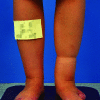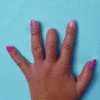Amniotic Band Syndrome in Adult Combined with Persistent Depressive Disorder
- PMID: 34055562
- PMCID: PMC8154472
- DOI: 10.1097/GOX.0000000000003594
Amniotic Band Syndrome in Adult Combined with Persistent Depressive Disorder
Abstract
Congenital amniotic band syndrome (ABS) is an anomaly with no proven etiology occurring in 0.7 per 10,000 live births. This defect mostly concerns the extremities and is often accompanied by other developmental anomalies. There are many methods of treatment for this type of defect, such as simple excision and suturing, local V-Y plasty, Z-plasty, multiple Z "plasties" or multiple W plasties, plasty with deepithelized or non-deepithelized rectangular lobes, and rigottomies complemented with lipofilling. The literature most often describes cases of treated children. There are no case reports of ABS treatment in adults. However, failure to undertake such treatment in childhood may result in serious mental dysfunction. We present the case of a 39-year-old woman with congenital ABS, in whom failure to provide proper treatment in childhood resulted in persistent depressive disorder development. The applied treatment, consisting of multiple Z plasties, liposuction, and fat grafting, resulted in improved appearance of her lower extremity, as well as the cessation of mental symptoms.
Copyright © 2021 The Authors. Published by Wolters Kluwer Health, Inc. on behalf of The American Society of Plastic Surgeons.
Conflict of interest statement
Disclosure: All the authors have no financial interest to declare in relation to the content of this article.
Figures




Similar articles
-
[Release of amniotic constricted grooves by hemi-circumferential excision and skin closure without Z-plasty].Ann Chir Plast Esthet. 2022 Mar;67(2):73-80. doi: 10.1016/j.anplas.2022.01.004. Epub 2022 Feb 17. Ann Chir Plast Esthet. 2022. PMID: 35183393 French.
-
Late management of amniotic bands syndrome with incomplete syndactyly: A case report of 4-year-old child.Int J Surg Case Rep. 2024 Feb;115:109277. doi: 10.1016/j.ijscr.2024.109277. Epub 2024 Jan 19. Int J Surg Case Rep. 2024. PMID: 38262220 Free PMC article.
-
Surgical correction of congenital constriction band syndrome in children: Replacing Z-plasty with direct closure.Can J Plast Surg. 2008 Winter;16(4):221-3. doi: 10.1177/229255030801600409. Can J Plast Surg. 2008. PMID: 19949501 Free PMC article.
-
Amniotic band syndrome with significant orofacial clefts and disruptions and distortions of craniofacial structures.J Pediatr Surg. 2003 Apr;38(4):635-8. doi: 10.1053/jpsu.2003.50141. J Pediatr Surg. 2003. PMID: 12677585 Review.
-
Perinatal outcome after fetoscopic release of amniotic bands: a single-center experience and review of the literature.Ultrasound Obstet Gynecol. 2013 Oct;42(4):449-55. doi: 10.1002/uog.12510. Ultrasound Obstet Gynecol. 2013. PMID: 23671033 Review.
Cited by
-
Advanced Management of Distal Lower Extremity Congenital Constriction Bands for Foot Salvage.Plast Reconstr Surg Glob Open. 2024 Sep 18;12(9):e6181. doi: 10.1097/GOX.0000000000006181. eCollection 2024 Sep. Plast Reconstr Surg Glob Open. 2024. PMID: 39296613 Free PMC article.
References
-
- Patterson TJ. Congenital ring-constrictions. Br J Plast Surg. 1961; 14:1–31. - PubMed
-
- Granick MS, Ramasastry S, Vries J, et al. . Severe amniotic band syndrome occurring with unrelated syndactyly. Plast Reconstr Surg. 1987; 80:829–832. - PubMed
-
- Mutaf M, Sunay M. A new technique for correction of congenital constriction rings. Ann Plast Surg. 2006; 57:646–652. - PubMed
-
- Napiontek M, Harasymczuk J. Surgical treatment of active amniotic band syndrome (ABS) by Z-plasty and radical excision of the overgrown tissue. A report of 2 cases with progressive lymphedema causing vascular insufficiency. J Pediatr Orthop. 2015; 35:516–518. - PubMed
-
- Tan PL, Chiang YC. Triangular flaps: a modified technique for the correction of congenital constriction ring syndrome. Hand Surg. 2011; 16:387–393. - PubMed
Publication types
LinkOut - more resources
Full Text Sources
Other Literature Sources
